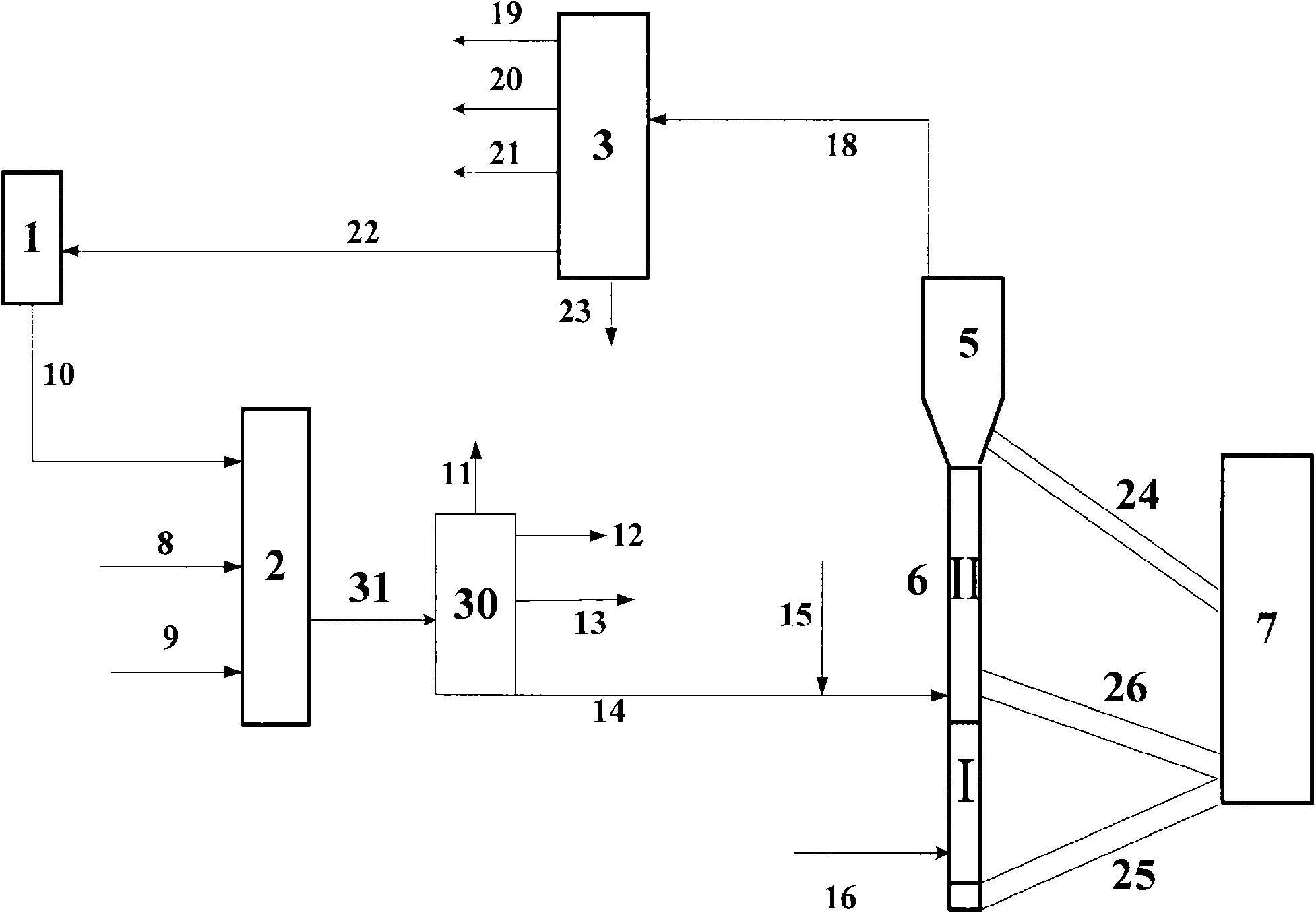Improved hydrotreatment and catalytic cracking combination method for hydrocarbon oil
A catalytic cracking and hydrotreating technology, applied in hydrotreating process, treating hydrocarbon oil, petroleum industry, etc., can solve the problems of poor selectivity of gasoline or diesel with adjustable product distribution, and achieve higher yield, improved efficiency, The effect of increasing the depth of cracking transformation
- Summary
- Abstract
- Description
- Claims
- Application Information
AI Technical Summary
Problems solved by technology
Method used
Image
Examples
Embodiment 1
[0053] This example illustrates the following figure 1 The effect of process processing shown.
[0054] Wherein, the feedstock oil that enters the hydroprocessing reaction unit is feedstock oil A, and the product distribution of hydroprocessing reaction conditions and hydroprocessing oil is listed in Table 2, wherein the hydrogenated tail oil generated is named as hydrogenated tail oil C, Feed E is a commonly used catalytic cracking feed. Hydrogenated tail oil C and feed E accounted for 20% by weight and 80% by weight of the total feed, respectively. Feed E obtains light oil fraction H (distillation range is 350-500 ℃, accounts for 44% by weight of feed E) and heavy oil fraction G (distillation range is higher than 500 ℃, accounts for 44% by weight of feed E) through distillation respectively 56% by weight), various feed properties are listed in Table 3-1. The heavy distillate G and the hydrogenated tail oil C are introduced into the catalytic cracking reaction zone I toget...
Embodiment 2
[0058] This example illustrates the following figure 1 The effect of process processing shown.
[0059] Wherein, the feed oil that enters the hydroprocessing reaction unit is feed oil B, and the product distribution of hydroprocessing reaction conditions and hydroprocessing oil is listed in Table 2, wherein the hydrogenated tail oil that generates is named as hydrogenated tail oil D, Feed E is a common catalytic cracking feed (same as in Example). Hydrogenated tail oil D and feed E accounted for 70% by weight and 30% by weight of the total feed, respectively. Feed E obtains light oil fraction H (distillation range is 350-500 ℃, accounts for 44% by weight of feed E) and heavy oil fraction G (distillation range is higher than 500 ℃, accounts for 44% by weight of feed E) through distillation respectively 56% by weight), various feed properties are listed in Table 3-1. The heavy distillate G and the hydrogenated tail oil D are introduced into the catalytic cracking reaction zon...
Embodiment 3
[0063] This example illustrates the following figure 2 The effect of process processing shown.
[0064] Wherein, the feedstock oil that enters the hydroprocessing reaction unit is feedstock oil A, and the product distribution of hydroprocessing reaction conditions and hydroprocessing oil is listed in Table 2, wherein the hydrogenated tail oil generated is named as hydrogenated tail oil C, Feed E is a common catalytic cracking feed (same as Example 1). Hydrogenated tail oil C and feed E accounted for 20% by weight and 80% by weight of the total feed, respectively. Feed E obtains light oil fraction H (distillation range is 350-500 ℃, accounts for 44% by weight of feed E) and heavy oil fraction G (distillation range is higher than 500 ℃, accounts for 44% by weight of feed E) through distillation respectively 56% by weight), various feed properties are listed in Table 3-2. The heavy distillate G is introduced into the catalytic cracking reaction zone I alone, and the light dis...
PUM
 Login to View More
Login to View More Abstract
Description
Claims
Application Information
 Login to View More
Login to View More - R&D
- Intellectual Property
- Life Sciences
- Materials
- Tech Scout
- Unparalleled Data Quality
- Higher Quality Content
- 60% Fewer Hallucinations
Browse by: Latest US Patents, China's latest patents, Technical Efficacy Thesaurus, Application Domain, Technology Topic, Popular Technical Reports.
© 2025 PatSnap. All rights reserved.Legal|Privacy policy|Modern Slavery Act Transparency Statement|Sitemap|About US| Contact US: help@patsnap.com



